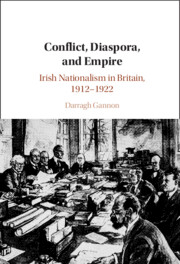Book contents
- Conflict, Diaspora, and Empire
- Conflict, Diaspora, and Empire
- Copyright page
- Contents
- Acknowledgements
- Introduction
- 1 Nationalists, Separatists, and the British Political Maze
- 2 Volunteers, War, and Rebellion
- 3 Nationalists, Republicans, and the Politics of War
- 4 Democracy, Citizenship, and the Irish National Ideal
- 5 Arms, Conflict, and Post-War Violence
- Conclusion
- Index
2 - Volunteers, War, and Rebellion
Published online by Cambridge University Press: 15 June 2023
- Conflict, Diaspora, and Empire
- Conflict, Diaspora, and Empire
- Copyright page
- Contents
- Acknowledgements
- Introduction
- 1 Nationalists, Separatists, and the British Political Maze
- 2 Volunteers, War, and Rebellion
- 3 Nationalists, Republicans, and the Politics of War
- 4 Democracy, Citizenship, and the Irish National Ideal
- 5 Arms, Conflict, and Post-War Violence
- Conclusion
- Index
Summary
Chapter two examines the conflicting nationalist politics mobilising Irish volunteers in wartime Britain. It profiles the political languages and cultures of Irish volunteers in British centres, from the 150,000 recruits in the British armed forces to the eighty-seven rebels in the armed forces of the Irish Republic; interrogates the correspondence, and separation, of Irish nationalist identities between home/front; and charts the rise, and estranged demise, of Irish Party support in wartime Britain. The Irish Party, this chapter submits, successfully maintained its ‘two face’ political position in Britain, in anticipation of a short war and a bitterly contested general election on the Home Rule issue, a political strategy termed ‘home front nationalism’. Redmond’s rejection of a British Cabinet position in May 1915, and the I.P.P.’s rejection of conscription in January 1916, however, fatally undermined the Irish Party’s policy. The participation of British-based Irish Volunteers in the 1916 Rising was a rebellion against the wartime politics of ‘home front nationalism’ and British citizenship. An examination of the ‘British connection’ to the Rising, from the Edinburgh-born James Connolly to the London-based Michael Collins, supports the thesis that military strategy was not the primary focus of the 1916 leaders.
Keywords
- Type
- Chapter
- Information
- Conflict, Diaspora, and EmpireIrish Nationalism in Britain, 1912–1922, pp. 69 - 120Publisher: Cambridge University PressPrint publication year: 2023



